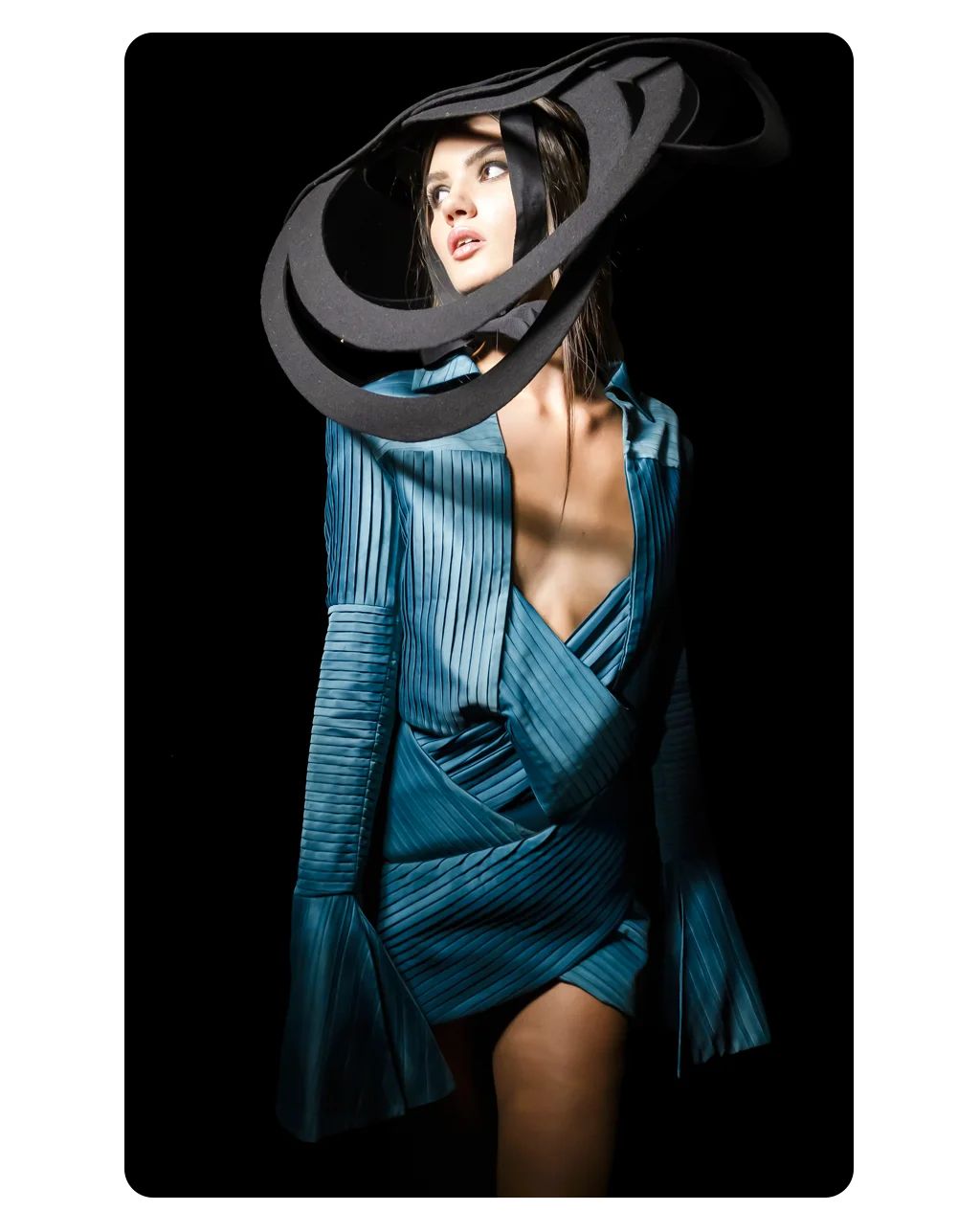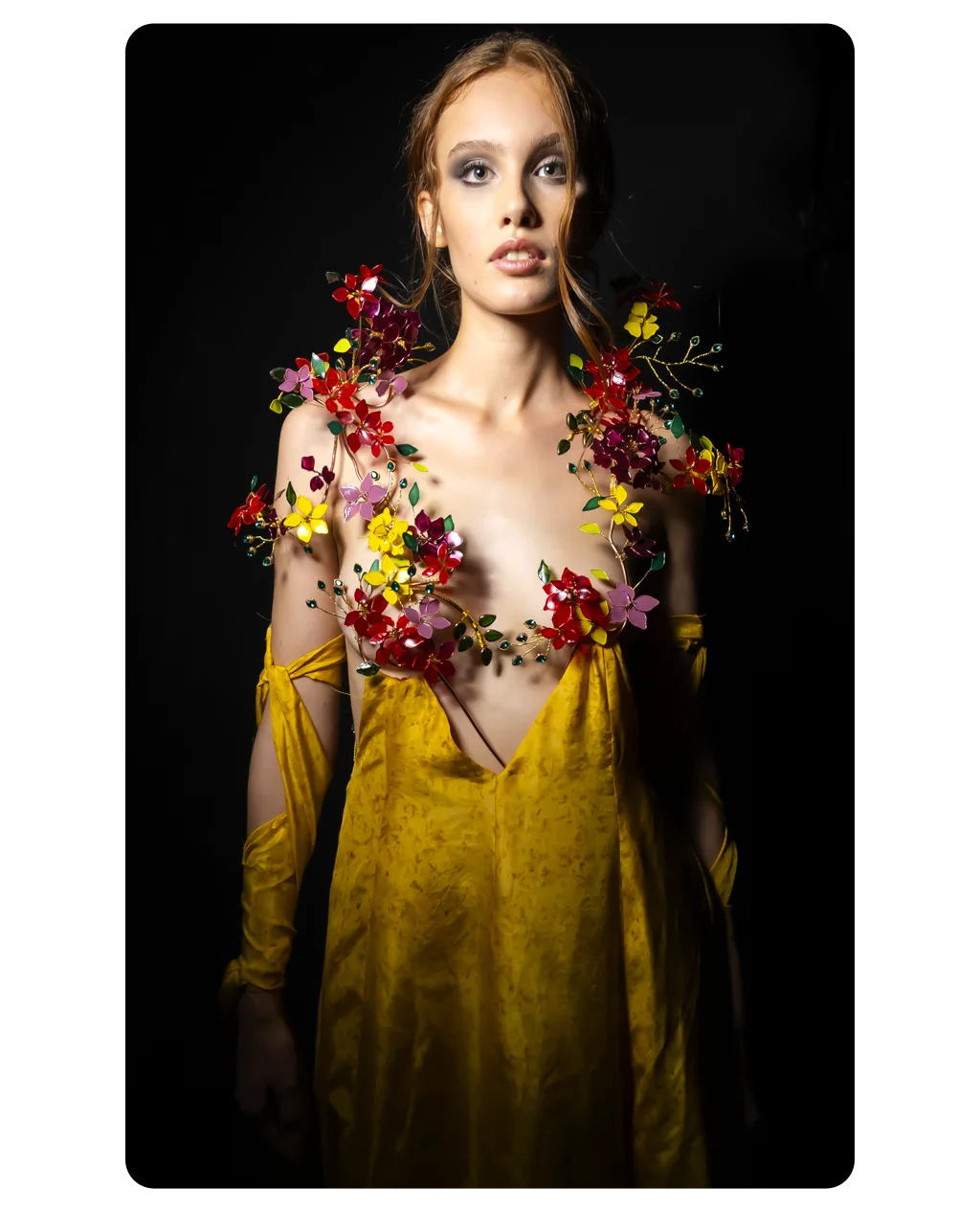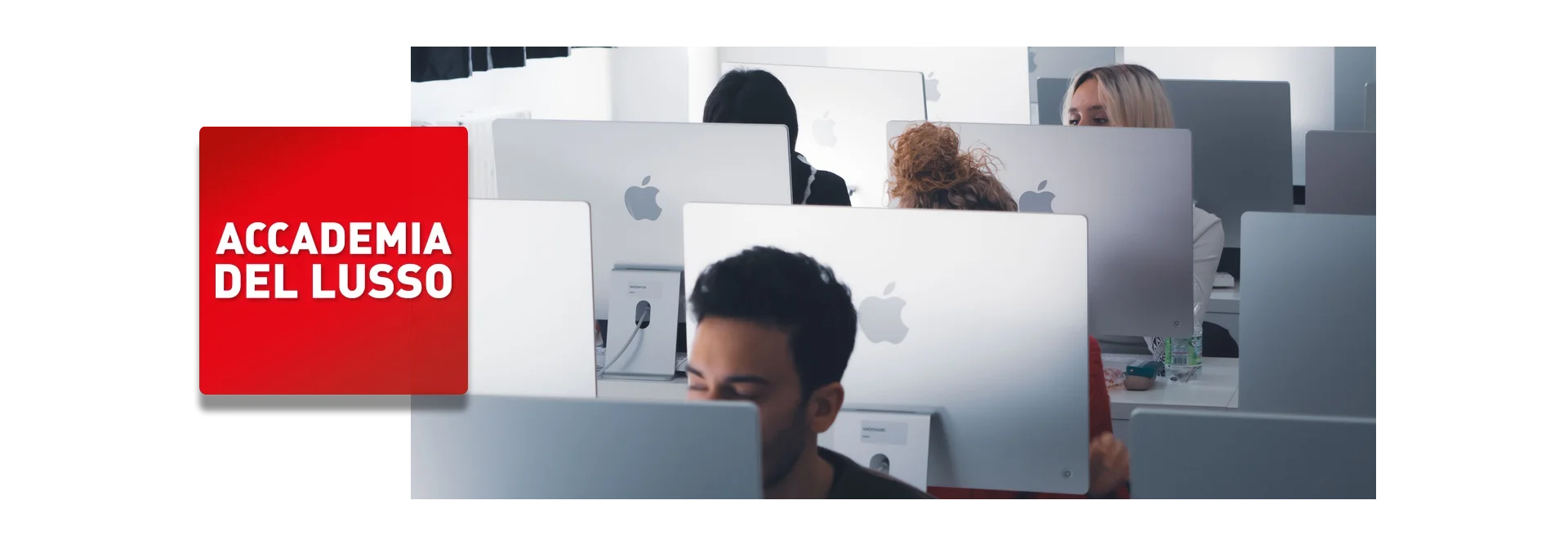BACHELOR'S DEGREE
Fashion Design
Attendance
Duration
Language
Locations
Start date
Enrolment
Class size
Tuition fees
Non-EU citizens: €21.350
Objectives of the Fashion Design degree course
Our 3-year Bachelor’s degree in Fashion Design boasts a comprehensive and forward-looking curriculum that guides students to become confident, competitive professionals in the creative areas of the fashion industry.
From the first year, students will learn patternmaking and dressmaking techniques, digital tools including CAD design, how to communicate fashion products, as well as textile design, brand design, and sketching and stylization. Students will also learn about sustainable fashion and be actively encouraged to practice sustainable methods and use new technologies for a responsible production.
A solid grounding in the history of fashion, design, and art as well as in-depth analyses of the current global fashion scene ensures students gain a competitive understanding of the industry and can draw on their knowledge to create products with critical awareness, strategic thinking, and cultural and social sensitivity.
Students will be supported in their creative development through industry-based and practice-led projects that encourage experimentation and innovation, under the guidance of expert teachers who have a wealth of knowledge and experience within the fashion industry.
A wide range of real-world activities such as workshops, visits, seminars, networking opportunities and sector events supplement classroom learning to offer valuable experience and contacts within the fashion industry.

Throughout the course, students will develop the strategic, creative, practical, and professional skills that will ensure they are ready to embark on a successful career within the global fashion and luxury sector.
By the end of the course, students will have designed and developed a whole fashion collection and professional portfolio that they can use for future career possibilities. Students will also have the chance to take part in the end of year student Fashion Show, a professional-standard event within a popular venue in Milan in front of an audience comprising industry professionals, influencers, and media.
Qualification
Bachelor’s degree (accredited), awarding 180 credits (ECTS)
Entry Requirements
- Secondary school (high school) diploma or equivalent
- Suitable level of English
Please see How to apply for information on admissions procedures


Teaching Method
At Accademia del Lusso you will be taught by working professionals from the fashion and luxury sectors who have a wealth of knowledge and experience.
The 3-year Bachelor’s degree course in Fashion Design contains a mixture of different teaching and learning techniques to develop a varied skill set and ensure a dynamic learning experience.
Lectures are combined with workshops and project work both in and out of the school, and field trips to companies, fashion events, trade fairs, and important fashion locations will take place throughout the three years of the course.
Classroom Lessons
External Visits
Seminars
Work Weeks and Workshops
Study Plan
- First Year
-
- Art History 1
Sector Code:ABST47 - CFA:4 - The main artistic movements from the Renaissance to the end of the 18th century. The evolution of styles in relation to the world of fashion and applied arts
- Pattern Making and Prototyping 1
Sector Code:ABST48 - CFA:4 - The language of pattern making and garment construction. Creation of basic pattern blocks for tops, dresses, skirts, and trousers with simple patterns. Introduction to garment construction techniques with practice on fabrics
- Computer Graphics for Fashion 1
Sector Code:ABTEC38 - CFA:4 - Tools for manipulating digital images. Basic use of image editing software, working with layers and masks, retouching tools
- Product Communication for Fashion 1
Sector Code:ABPC67 - CFA:8 - Vocabulary and tools for understanding communication techniques. Analysis of advertising campaigns: structure and content
- Textile Design 1
Sector Code:ABPR34 - CFA:3 - Creation of pattern modules. Printing techniques in the textile industry. Textile supports for printing. Application to projects
- Textile Culture and Color
Sector Code:ABPR34 - CFA:9 - Analysis and evolution of textile products from their origins to the present day. Perceptual, communicative, social, symbolic, aesthetic, and synthetic aspects of color
- Brand design
Sector Code:ABLE69 - CFA:7 - Strategic marketing. Needs identification. Competition analysis. Effective promotion. Leading companies: case histories.
- History of Fashion and Design 1
Sector Code:ABST48 - CFA:6 - The historical evolution of fashion and costume from the beginnings of Mesopotamian textiles to the early European and American 20th century.
- Fashion design 1
Sector Code:ABPR34 - CFA:5 - Fundamentals of drawing for fashion figure and technical drawing. Basic principles of stylization. Silhouette creation for fashion design. Rendering techniques. Development of personal style. Knowledge of processes for creating fashion products and collections.
- Brand design
Sector Code:ABLE69 - CFA:7 - Strategic marketing. Needs identification. Competition analysis. Effective promotion. Present and future scenarios in the fashion and luxury world. Leading companies: case histories.
- Language 1
Sector Code:ABLIN71 - CFA:8 - English language and review of grammar rules. Written exercises, tests, conversations, dialogues, readings related to the world of fashion.
- Art History 1
- Second Year
-
- Art History 2
Sector Code:ABST47 - CFA:4 - Overview of major contemporary artists. Analysis of the relationship between art and fashion. Comparison between the work of artists and designers. Artistic languages in fashion.
- History of Fashion and Design 2
Sector Code:ABST48 - CFA:6 - National and international overview of the latest trends in fashion design. Analysis of emerging brands and comparison with established brands. Dynamics underlying new forms of design.
- Modeling and Prototyping Laboratory 2
Sector Code:ABPR21 - CFA:5 - Construction of patterns. The human body and its forms. Modeling and fit. Garment construction techniques with samples of finishes and details.
- Textile Design 2
Sector Code:ABPR34 - CFA:3 - Tools for designing a fashion print collection. Digital design of patterns for printed fabrics, in line with market trends. Customization of design and professional execution.
- CAD Modeling Techniques 1
Sector Code:ABTEC41 - CFA:4 - Introduction to the use of software for digitizing basic patterns. Overview of fabrics. Size grading.
- Fashion Design 2
Sector Code:ABPR34 - CFA:5 - Fashion design. Development of women's, menswear, sportswear, and knitwear collections. Trend research. Material and color selection. Development of the merchandising plan.
- Accessories Design
Sector Code:ABPR34 - CFA:3 - Development and composition of an accessories collection. Naming of accessories: footwear, bags, belts. Materials. Merchandising plan.
- Eco-Fashion and Innovative Techniques for Fashion
Sector Code:ABPR34 - CFA:6 - The world of sustainable fashion in the perspective of ethical/global product development. Sustainable materials and production processes. New technologies for more responsible production. Human rights in the global textile industry.
- Psychology and Sociology of Color Applied to Design
Sector Code:ABST58 - CFA:2 - The psychological and emotional aspects of color in fashion and marketing. Implications of cultural differences in the use and aesthetics of color. Communicative strategies and social behaviors for the establishment of iconic colors in fashion.
- Elements of Copyright
Sector Code:ABLE70 - CFA:3 - Elements of private law for copyright protection in the publishing field. Methods to safeguard the intellectual property of one's work.
- Language 2
Sector Code:ABLIN71 - CFA:8 - English language and review of grammar rules. Written exercises, tests, conversations, dialogues, readings related to the world of fashion.
- Art History 2
- Third Year
-
- Laboratorio Modelling and Prototyping 3
Sector Code:ABPR21 - CFA:6 - Advanced skills in pattern making and garment construction for the realization of the final collection.
- Computer Graphics for Fashion 3
Sector Code:ABTEC38 - CFA:4 - Techniques for developing a professional portfolio and creating online graphic presentations.
- Textile Manipulation Techniques
Sector Code:ABPR34 - CFA:3 - Analysis, study, and exercises on the main techniques for fabric and material decoration, such as embroidery, dyeing, and finishing.
- CAD Pattern Making Techniques 2
Sector Code:ABTEC41 - CFA:4 - Basic knowledge of CAD 3D modeling software and its main applications in the textile industry. Creation of 3D models of previously designed garments up to the prototype stage.
- Fashion Brand Management
Sector Code:ABLE69 - CFA:6 - Definition of brand identity as a strategic lever for the success of fashion products and brands. Distinctive features of the brand, brand awareness, brand loyalty, co-branding. Process analysis. Analysis of sampling and production costs.
- Language 3
Sector Code:ABLIN71 - CFA:9 - Conversation in English on selected articles by students. Preparation of a curriculum in English and role play for job interview preparation.
- Fashion Start-up Management
Sector Code:ABLE69 - CFA:7 - How to start a fashion entrepreneurial project. Main business models in the industry. Principles of modern entrepreneurship.
- Elective Credits among optional subjects, labs, and work weeks
CFA:10 - Individual Work under Tutoring
CFA:12
- Laboratorio Modelling and Prototyping 3
Careers
The Fashion Design course trains a professional who is capable of analysing, developing, and supervising the creation of fashion products, from the initial idea to the final creation and distribution. The course provides professional skills that enable students to produce design ideas and develop a fashion project based on a thorough knowledge of the sector's trends.
Work Internships
Our aim is to prepare students to enter the fashion world effectively and quickly. To this end, our placement service is constantly working to consolidate partnerships with the most prestigious fashion brands, the most original maisons, and the most innovative start-ups. We have built stable yet dynamic relationships that promote talent and our vision of sustainable innovation in fashion & luxury. Our Careers Office is in contact with some of the best companies and agencies: this allows 90% of students to find important internships or professional collaborations within 6/8 months from the end of their course.

Career Opportunities
What are some of the main career opportunities offered by the bachelor’s degree course in Fashion Design?-
01. Fashion Designer - the mind behind the artistic creation of a garment or accessory. Designers study fashion trends, develop sketches, select colours and fabrics, and oversee the final production of their designs.
02. Fashion Coordinator- oversees all the projects for one or more product lines and is responsible for brand strategy. Coordinates and supervises the processes and departments for the different lines, and manages the production process, sales, collections, and advertising.
-
03. Cool Hunter - professional 'trend hunters' in the fashion industry. Their job is to identify trends and new styles that fashion businesses can use to develop innovative products and anticipate market needs.
-
04. Image Consultant - develops strategies to transform a client's image, suggesting changes that are both in line with the latest trends in the fashion world and also consider the client's physicality and personality.